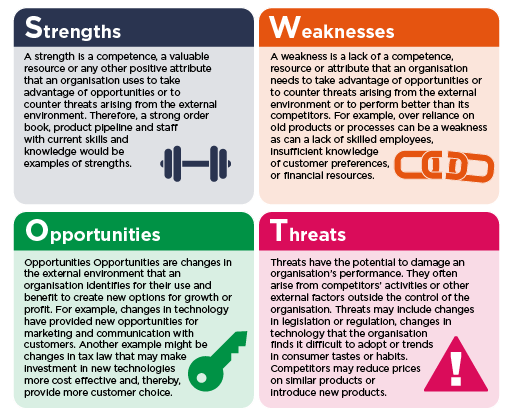Challenge 5 Making sense of it all
Well done – if you have made it to this final challenge by completing the others you will have accumulated a great deal of insight and knowledge about your organisation – some of it may be newly acquired and other insights may have brought some new perspective.
In the introduction it was suggested that commercial awareness was a critical skill for employees in their personal and professional development. However, when shared it can also produce insights and ideas of great benefit to the organisations, as it is through the process of sharing, exchanging and applying information that organisations, as well as individuals, learn and progress.
In this final challenge we are going to introduce (or perhaps revert to) the SWOT analysis. Many organisations elect to use SWOT as an exercise in recruitment and selection, so why not put this into practice with that in mind. For this knowledge and insight to be of use, the final challenge is where you bring together all your accumulated insights in such a way that you can explain and present it to others.
For this, we use the tried and tested (though often poorly used) SWOT analysis.
Full definitions of the SWOT diagram above can be read in the Summary section [Tip: hold Ctrl and click a link to open it in a new tab. (Hide tip)] of this challenge
A SWOT analysis can be applied in several ways. It can look at the whole organisation or from just one perspective such as how well prepared for the future your department is working. It might also help you to understand your own personal development – e.g. what do you need to learn or do to improve your career prospects, what personal strengths could you use to take advantage of future opportunities, and so on.
A SWOT analysis identifies and analyses those internal and external factors that can impact on the viability of a project, product or business. It helps people assess issues within and outside their organisation. Strengths and weaknesses are often internal to an organisation, while opportunities and threats generally relate to external factors.
The final challenge – tips for a great SWOT
Your challenge this time is to populate your own SWOT analysis with the findings you have revealed through the previous four challenges.
Here are some hints that could be helpful to do that:
Start by deciding at what level you want to make your analysis (what is its purpose?). Is this for you, your department, the business unit or wider. Not all the information you uncovered will apply to all these perspectives.
Logically its makes most sense to start by considering the external threats and opportunities you were asked to consider while looking at the external environment (Challenge 1), competitors, and customers before attempting to align your own or your organisation/team/department’s position against these.
Opportunities are only relevant in relation to the strengths and weaknesses of the person or body that is considering them. If you do not have the capacity, capability, resources, access, agility or will to take advantage of an opportunity, then it isn’t a realistic one for you.
Opportunities arising from the external environment are in theory there for any potential competitor – hence there may be a number of alternative ways to take advantage of them but perhaps fewer that are available to you or the organisation.
A good list of threats and opportunities will not necessarily be a long one. Keep your list focused by being realistic about the priority/urgency or influence threats have. Equally, this applies to opportunities. This means making qualitative judgements about their significance.
Attempts to quantify threats and opportunities will not only help to prioritise them but also focus the mind on those with the greatest likely impact. Threats are not “absolute”, they only have potential to be a threat without any mitigating action. Your analysis should focus on considering how your strengths could produce alternative ways and strategies to counteract any weaknesses in relation to the threat. It is even possible that is through the act of identifying in advance and planning ahead that the threat can be alleviated, and even become an opportunity through early-mover advantage.
A SWOT analysis is not a fixed position but more a dynamic model of how you and your organisation adapts to the changing operating environment that you are in.
Capture your own ideas in a SWOT analysis. Your final challenge is to share it with one or two colleagues and consider their reaction to it.
Do they agree with your analysis? Do they have anything to add or disagree with? What could you do now with this analysis.
You can now go to the Summary.

